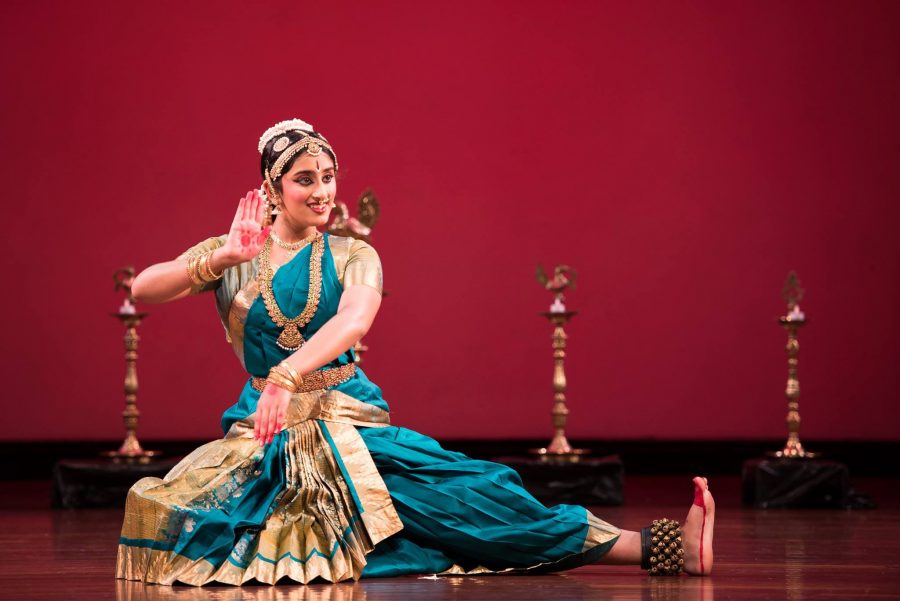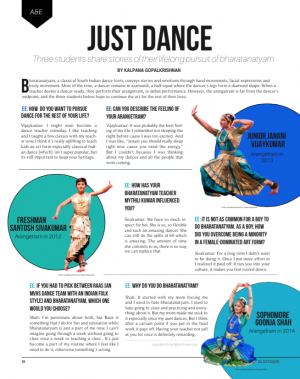Bharatanatyam, a classical South Indian dance form conveys stories and emotions through hand movements, facial expressions and body movement. Most of the time, a dancer remains in aramandi, a half-squat where the dancer’s legs form a diamond shape. When a teacher deems a dancer ready, they perform their arangetram, or debut performance. However, the arangatram is far from the dancer’s endpoint, and the three students below hope to continue the art for the rest of their lives.
Freshman Santosh Sivakumar
Current Teacher: Mythili Kumar
Performed Arangetram in 2012
EE: It is not as common for a boy to do bharatanatyam. As a boy, how did you overcome being a minority in a female-dominated art form?
Sivakumar: For a long time I didn’t want to be doing it. Once I put more effort in I realized it paid off. It ties you into your culture, it makes you feel rooted down.
EE: How has your bharatanatyam teacher [Mythili Kumar] influenced you?
Sivakumar: We have so much respect for her. She is so, so flexible and such an amazing dancer. She can still do the splits at 60 which is amazing. The amount of time she commits to us, there is no way we can replace that.
Sophomore Goonja Shah
Current Teacher: Mythili Kumar
Performed Arangetram in 2014
EE: Why do you do bharatanatyam?
Shah: It started with my mom forcing me and I used to hate bharatanatyam. I used to hate going to class and practicing and everything about it. But my mom made me stick to it especially since my aunt dances. But I think after a certain point if you put in the hard work it pays off. Having your teacher not yell at you for once is definitely rewarding.
EE: If you had to pick between Raas [an MVHS dance team with an Indian folk style] and bharatanatyam, which one would you choose?
Shah: I’m passionate about both, but Raas is something that I do for fun and relaxation while bharatanatyam is just a part of me now. I can’t imagine going through a week without going to class once a week or teaching a class . It’s just become a part of my routine where I feel like I need to do it, otherwise something’s wrong.
EE: What would your bharatanatyam teacher [Mythili Kumar] have said if you chose Raas?
Shah: She would have killed [Sivakumar and I.] We’re not allowed to do Bhangra or Raas. She knows about it but she’s not happy about it. We always just say we have a “study session.”
Junior Janani Vijaykumar
Current Teacher: Radica Giri
Performed Arangetram in 2014
EE: How do you want to pursue dance for the rest of your life?
I might even become a dance teacher someday. I like teaching and I taught a few classes with my teacher now. I think its really uplifting to teach little kids an art form especially classical Indian dance [which] isn’t super popular, but its still important to keep your heritage.
EE: How do you think bharatanatyam is different from what a person usually thinks of “dance”?
I think people think of hip hop and ballet and all types of American dancing, because that’s what we usually see on TV. Specific things about Indian classical are different, like there’s your form and a certain look and a certain face. It’s something you don’t see often, especially here in America.
EE: Can you describe the feeling of your arangetram?
It was probably the best feeling of my life. I remember not sleeping the night before cause I was too excited. And I was like, “Janani you should really sleep right now cause you need the energy.” But I couldn’t because I was thinking about my dances and all the people that were coming.






